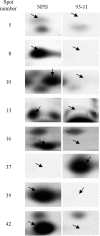Comparative proteomic analysis of indica and japonica rice varieties
- PMID: 25505840
- PMCID: PMC4261965
- DOI: 10.1590/S1415-47572014005000015
Comparative proteomic analysis of indica and japonica rice varieties
Abstract
Indica and japonica are two main subspecies of Asian cultivated rice (Oryza sativa L.) that differ clearly in morphological and agronomic traits, in physiological and biochemical characteristics and in their genomic structure. However, the proteins and genes responsible for these differences remain poorly characterized. In this study, proteomic tools, including two-dimensional electrophoresis and mass spectrometry, were used to globally identify proteins that differed between two sequenced rice varieties (93-11 and Nipponbare). In all, 47 proteins that differed significantly between 93-11 and Nipponbare were identified using mass spectrometry and database searches. Interestingly, seven proteins were expressed only in Nipponbare and one protein was expressed specifically in 93-11; these differences were confirmed by quantitative real-time PCR and proteomic analysis of other indica and japonica rice varieties. This is the first report to successfully demonstrate differences in the protein composition of indica and japonica rice varieties and to identify candidate proteins and genes for future investigation of their roles in the differentiation of indica and japonica rice.
Keywords: indica and japonica rice; molecular marker; proteomics; quantitative real-time PCR; unique proteins.
Figures






Similar articles
-
Characterisation of Indica Special Protein (ISP), a marker protein for the differentiation of Oryza sativa subspecies indica and japonica.Int J Mol Sci. 2014 Apr 29;15(5):7332-43. doi: 10.3390/ijms15057332. Int J Mol Sci. 2014. PMID: 24786093 Free PMC article.
-
A collection of 10,096 indica rice full-length cDNAs reveals highly expressed sequence divergence between Oryza sativa indica and japonica subspecies.Plant Mol Biol. 2007 Nov;65(4):403-15. doi: 10.1007/s11103-007-9174-7. Epub 2007 May 24. Plant Mol Biol. 2007. PMID: 17522955
-
Microsatellite diversity within Oryza sativa with emphasis on indica-japonica divergence.Genet Res. 2005 Feb;85(1):1-14. doi: 10.1017/s0016672304007293. Genet Res. 2005. PMID: 16089032
-
Genetic dissection of agronomically important traits in closely related temperate japonica rice cultivars.Breed Sci. 2017 Dec;67(5):427-434. doi: 10.1270/jsbbs.17053. Epub 2017 Nov 15. Breed Sci. 2017. PMID: 29398936 Free PMC article. Review.
-
Introgression among subgroups is an important driving force for genetic improvement and evolution of the Asian cultivated rice Oryza sativa L.Front Plant Sci. 2025 Feb 20;16:1535880. doi: 10.3389/fpls.2025.1535880. eCollection 2025. Front Plant Sci. 2025. PMID: 40051880 Free PMC article. Review.
Cited by
-
Identification and Characterization of BmVta1, a Bombyx mori (Lepidoptera: Bombycidae) Homologue for Vta1 That is Up-Regulated in Development.J Insect Sci. 2017 May 1;17(3):79. doi: 10.1093/jisesa/iex055. J Insect Sci. 2017. PMID: 28973578 Free PMC article.
-
Ascribing Functions to Genes: Journey Towards Genetic Improvement of Rice Via Functional Genomics.Curr Genomics. 2016 Jun;17(3):155-76. doi: 10.2174/1389202917666160202215135. Curr Genomics. 2016. PMID: 27252584 Free PMC article.
-
Enhancement Methods of Antioxidant Capacity in Rice Bran: A Review.Foods. 2022 Sep 26;11(19):2994. doi: 10.3390/foods11192994. Foods. 2022. PMID: 36230070 Free PMC article. Review.
-
Evolutionary relationships and expression analysis of EUL domain proteins in rice (Oryza sativa).Rice (N Y). 2017 Dec;10(1):26. doi: 10.1186/s12284-017-0164-3. Epub 2017 May 30. Rice (N Y). 2017. PMID: 28560587 Free PMC article.
-
Lectin Sequence Distribution in QTLs from Rice (Oryza sativa) Suggest A Role in Morphological Traits and Stress Responses.Int J Mol Sci. 2019 Jan 20;20(2):437. doi: 10.3390/ijms20020437. Int J Mol Sci. 2019. PMID: 30669545 Free PMC article.
References
-
- Agrawal GK, Rakwal R. Rice proteomics: A move toward expanded proteome coverage to comparative and functional proteomics uncovers the mysteries of rice and plant biology. Proteomics. 2011;11:1630–1649. - PubMed
-
- Agrawal GK, Jwa NS, Iwahashi Y, Yonekura M, Iwahashi H, Rakwal R. Rejuvenating rice proteomics: Facts, challenges, and visions. Proteomics. 2006;6:5549–5576. - PubMed
-
- Bevan M, Bancroft I, Bent E, Love K, Goodman H, Dean C, Bergkamp R, Dirkse W, Van Staveren M, Stiekema W, et al. Analysis of 1.9 Mb of contiguous sequence from chromosome 4 of Arabidopsis thaliana. Nature. 1998;391:485–488. - PubMed
-
- Bradford MM. A rapid and sensitive method for the quantitation of microgram quantities of protein utilizing the principle of protein-dye binding. Anal Biochem. 1976;72:248–254. - PubMed
-
- Chi F, Yang P, Han F, Jing Y, Shen S. Proteomic analysis of rice seedlings infected by Sinorhizobium meliloti 1021. Proteomics. 2010;10:1861–1874. - PubMed
Internet Resources
-
- Mascot program, http://www.matrixscience.com November 30, 2012.
-
- InterProscan program, http://www.ebi.ac.uk/Tools/InterProScan January 9, 2013.
-
- WEGO software, http://wego.genomics.org.cn January 10, 2013.
LinkOut - more resources
Full Text Sources
Other Literature Sources

